2 中国地质科学院岩溶地质研究所/国土资源部、广西岩溶动力学重点实验室, 广西 桂林 541004)
小冰期(Little Ice Age,简称LIA)这一名词最初来源于冰川学研究,由Matthes[1]于1939年提出,用来描述“全新世最暖期之后冰川中等规模复活的寒冷时期”。现在人们所称的LIA与之不同,主要作为一个气候学概念来指代距现代最近的一次全球性寒冷期[2~5]。LIA期间的气候变化对于人类社会的发展演变产生了重要影响[6],明确LIA阶段的气候特征对于揭示气候变化规律、辨识气候变化自然背景、认识人类活动与气候变化相互作用、预估未来气候变化并采取应对措施等具有重要意义[7~8]。
近十几年来,众多学者利用历史文献[9~11]、冰芯[12]、海洋沉积物[13]、洞穴石笋[4, 14~24]、湖泊沉积物[25~27]、沼泽泥炭[28]、孢粉[29~30]、树木年轮[31~32]及模式模拟[33]等对小冰期气候变化特征展开研究并取得重要进展[34~35]。LIA气候变化在空间上存在着明显的区域差异[19, 36],例如,Chen等[35]总结中亚干旱区和亚洲季风区的71个记录,发现小冰期时中国东部季风区呈现北方干旱而南方湿润的南北两极模态;Tan等[37]将中国西南地区石笋同位素记录与过去两千年不同区域古降水资料对比,发现小冰期期间华北地区降雨显著减少,而热带华南、长江中下游、西南、西北地区降水均有所增加。高分辨率气候记录显示LIA在时间上存在次级的干湿冷暖波动[36, 38],王绍武等[39]利用代用资料重建中国过去千年平均温度序列发现小冰期内部存在3次冷期,即1450~1510A.D.(A.D.表示公元后,下同)、1600~1690A.D.、1780~1870A.D.;四川黑竹沟洞石笋氧同位素记录显示亚洲季风强度在LIA期间存在显著的十年际尺度振荡,在1600~1800A.D.期间存在5个强振荡旋回[18];Cui等[3]利用孢粉重建的长江中游地区古降水记录将LIA划分为3个阶段,即LIA早期(1300~1340A.D.)、LIA中期(1340~1720A.D.)和LIA晚期(1720~1870A.D.),前两个阶段均偏干,而LIA晚期降水有所增加。总的来说,目前在小冰期内部精细特征、区域差异等方面仍存在一定的争议[18, 35],利用气候敏感区的高分辨率古气候记录深化LIA期间气候变化研究对于解决有关问题极为重要。
董哥洞是较早开展石笋气候变化研究的洞穴之一,近20年来基于董哥洞石笋取得了一系列成果[14, 20~22, 40~44]。何尧启等[20]基于董哥洞DA和D15讨论了过去1000年西南季风降水变化过程,发现自1720A.D.以来西南季风强度突增;Zhao等[22]利用有年纹层的DX1和DX2样品得到了过去1200年来年分辨率的气候记录,结果显示1510~1630A.D.是过去千年最为突出的弱季风期,其中氧同位素在1570~1595A.D.明显偏重,之后迅速偏负。但早年研究由于技术限制等原因导致年代误差较大或者分辨率不足,对于小冰期内部精细结构和时空变化的关注也比较少。本文利用生长快速的董哥洞D41石笋,重建了1400~1880A.D.的高分辨率碳氧同位素气候记录,平均分辨率高于0.5年。在此基础上分析小冰期内部气候变化的精细特征,利用频谱分析研究周期特征,并通过对比中国不同洞穴的多个石笋记录,以明末崇祯大旱为例,结合历史文献记录分析短尺度气候变化的区域差异情况,进而尝试解释不同石笋氧同位素差异的原因。
1 研究区概况与样品测试 1.1 研究区概况董哥洞位于贵州南部荔波县洞塘乡(25°17′50.5″N,108°02′67″E)茂兰森林保护区的丛林区(图 1),区内年均温15.3℃,年均降水量1752mm,年均相对湿度83 %,属于亚热带温湿气候区[14]。该地区受到南海和孟加拉湾两个水汽源的影响,现代降雨氧同位素数据表明贵阳地区同时受到东亚季风和印度季风作用,属于亚洲季风敏感区[8, 22]。董哥洞洞口高程681m,洞穴顶板覆盖层厚约100m;该洞主、支洞道实测长1208m,洞宽3~55m,一般宽7~22m,洞高2.5~30m,一般高5~15m;洞穴有着较好的密闭性,洞内气温维持在15.2~16.4℃,洞穴的盖层植被为茂密的常绿落叶阔叶混交林[14]。
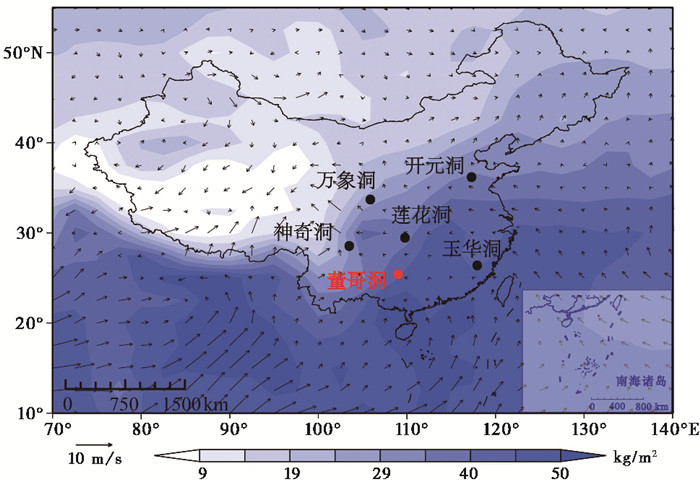
|
图 1 贵州董哥洞及相关记录所在位置 蓝色背景表示1987~2016年平均6~9月份整层大气积分的可降水含量;箭头表示同时期近地表风场(NCEP/NCAR再分析数据,http://www.esrl.noaa.gov/psd/);图片修改自Li等[45] Fig. 1 Locations of Dongge Cave and other relative records.The shading shows absolute value of precipitable water content (kg/m2) for the entire atmospheric column and the arrows indicate the surface wind field during 1987~2016A.D.based on the NCEP/NCAR reanalysis datasets, http://www.esrl.noaa.gov/psd/.This figure is modified from Li et al.[45] |
D41石笋样品为方解石,长约16cm,半径3~4cm,样品使用线切割机切割成厚约8mm薄片后使用磨片抛光。样品存在明显的颜色和致密度变化,并有着疏松(致密)部分颜色较浅(暗)的对应关系。样品未见沉积间断,但是考虑到底部存在溶蚀孔洞,只针对其上部约11.7cm进行了稳定同位素分析(图 2a)。
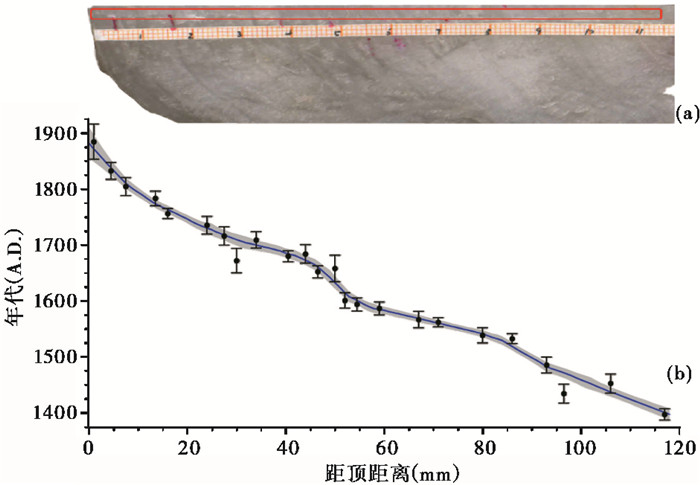
|
图 2 董哥洞D41石笋样品剖面图及年代模式 (a)样品剖面图,红色方框表示同位素采样位置;(b)使用ModAge程序[48]建立的年代模式,蓝线表示模型结果中心值,灰色条带表示模型2σ误差范围,黑色圆点和误差棒表示年代点和2σ误差范围 Fig. 2 Sample image and age model of D41 from Dongge Cave.(a)Scanned image of stalagmite D41. The red box marks the isotope subsampling track. (b)Age model reconstructed by the Modage program[48]. Blue curve dipict the mean value. The gray envelope shows 2σ error. 230Th dates are shown by error bars(2σ) |
本文相关实验于西安交通大学同位素实验室完成。年代样品使用直径为0.5mm的螺旋合金牙钻沿样品生长层在生长轴附近钻取粉末,考虑到样品铀含量较高(1~2 ppm,ppm表示10-6g/g)但较为年轻,采集约50~120mg粉末样品用于测试年代。化学分离步骤按照Edwards等[46]和Cheng等[47]的方法,分离后得到的铀和钍利用多接收电感耦合等离子体质谱仪Neptune_Plus(MC-ICP-MS)测试。稳定同位素分析使用New Wave MicroMill微量采样仪每毫米采集10个样品,样品测试使用Kiel-Ⅳ型碳酸盐自动进样装置联用MAT-253_Plus质谱仪,测试时每隔10~20个样品放一个碳酸盐标准样品TTB1,分析误差小于±0.05 ‰,结果相对于VPDB。
2 结果 2.1 年代模式本文共获得24个230Th年代(表 1),除1mm、30mm、50mm的年代误差较大外,其余定年结果的平均误差约为±15年,近一半样品误差为±10年左右。基于24个230Th年代点,利用ModAge程序[48]建立年代模型,该年代模型通过输入采样点年龄及其误差、距顶距离和采样点宽度,利用蒙特卡罗(Monte Carlo)模拟和局部加权回归拟合(LOESS)法[48]拟合得到石笋年龄分布情况(图 2b),拟合结果的年代误差(2σ)最大28年,最小5年,平均为9年。从11.7mm到顶端该石笋生长年代约为1400~1880A.D.,平均生长速率约为0.24mm/a,生长较快。
| 表 1 董哥洞D41石笋230Th定年结果(误差为2σ)* Table 1 230Th dating results of the stalagmite D41 from Dongge Cave with 2σ error |
利用石笋D41共获得1165组稳定同位素数据,结合年代模型重建了1400~1880A.D.碳氧同位素古气候记录(图 3),平均分辨率为0.41年。该样品氧同位素和碳同位素在研究时段内均表现出高频振荡,石笋δ18O在-8.19 ‰ ~-6.64 ‰之间变化,变幅1.55 ‰,平均值为-7.52 ‰;δ13C在-6.77 ‰ ~-1.67 ‰之间变化,变幅5.10 ‰,平均值为-5.14 ‰。δ18O和δ13C存在显著的正相关关系,二者Pearson线性相关系数为r=0.7882(n=1165,p<0.001)。D41氧同位素在年代际-百年尺度上存在5个变化趋势:1400~1450A.D.、1555~1630A.D.和1790~1880A.D.,石笋δ18O和δ13C高频振荡偏正;1450~1555A.D.和1630~1790A.D.存在偏负趋势,于1555A.D.和1790A.D.附近达到极小值。δ13C与δ18O变化趋势在1730A.D.前类似,此后略有差异,分别在1555A.D.、1730A.D.和1810A.D.附近达到极小值。
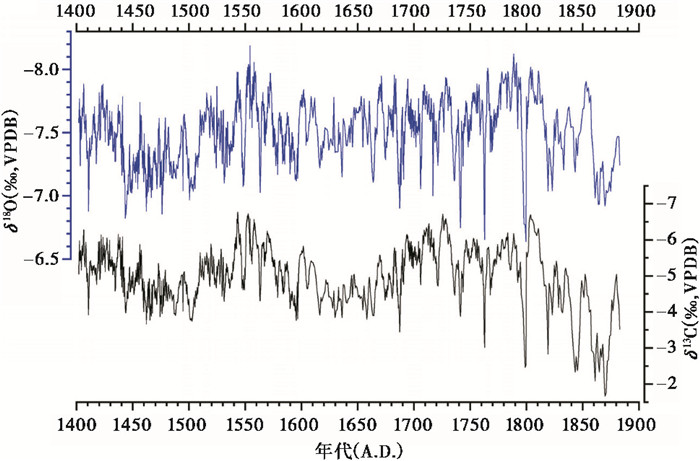
|
图 3 董哥洞D41石笋碳氧稳定同位素 上曲线为氧同位素,下曲线为碳同位素 Fig. 3 The time series of theδ18O(top curve)and δ13C (bottom curve) of D41 from Dongge Cave |
利用石笋稳定同位素研究气候变化需要进行平衡分馏检验以保证在石笋发育过程中方解石与岩溶水之间同位素达到平衡状态[4],在众多检验标准中,相同洞穴相同时段不同石笋样品间δ18O记录的可重复性是检验石笋氧同位素达到平衡分馏最有效的判据[49~50]。目前与本文研究时段相近,且已发表的董哥洞石笋δ18O典型记录有3条[22, 40]。这3条记录(DX1、DX2和DA)的δ18O范围和变化趋势与本文石笋D41一致(图 4):石笋DX1、DA与D41从1555A.D.到1600A.D.均显示逐渐变正的趋势(紫色箭头);石笋DX1、DX2、DA和D41从1670A.D.到1780A.D.均显示逐渐变负的趋势(绿色箭头);4条记录在多个细节表现为明显的相似(灰色色柱),尤其在1800A.D.前后,δ18O均出现短时期的明显偏重。与另外3条同一洞穴的石笋δ18O记录在变幅、趋势和细节特征等方面的一致性表明D41石笋δ18O通过了重复性检验,表明D41石笋δ18O可作为气候代用指标指代气候变化。
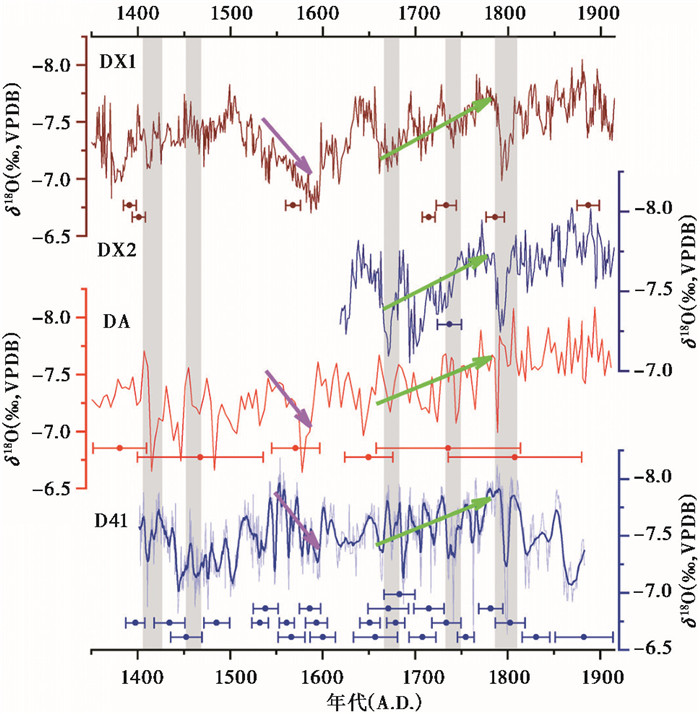
|
图 4 董哥洞不同石笋记录对比 自上而下分别为DX1[22]、DX2[22]、DA[40]和D41记录及其对应的年代误差(2σ),D41蓝色粗线为浅蓝色线的10点滑动平均;紫色和绿色箭头分别表示氧同位素变重和变轻趋势,灰色色柱标示了多个记录典型相似点 Fig. 4 Comparison ofδ18O records from Dongge Cave.From top to bottom:δ18O records and error bars of 230Th dates(2σ)for DX1[22], DX2[22], DA[40]and D41, respectively. The thick blue curve is the 10-point running average of the light blue curve. Purple(green)arrows indicateδ18O heavier (lighter)excursions, respectively. Gray bars depict the similarities between different records |
石笋同位素相关理论和研究表明洞穴石笋δ18O主要影响因素为洞穴内温度和渗水氧同位素的变化,其中温度的影响较小[8],而渗水主要来源于大气降水,反映降水氧同位素(δ18Op)的变化[51~52]。目前中国地区石笋氧同位素指代的气候意义还存在较多的争议,主要观点包括代表夏季风强度或者降水[4, 23, 40, 53~54]、环流效应[55~60]、大尺度环流特征[61]、水汽源区变化[62]以及从水汽源区到洞穴的空间集成降雨量[63],等[64~65]。
Yuan等[41]引入瑞利分馏并提出从水汽源到洞穴之间传输路径的水汽凝结降水量是洞穴石笋δ18O记录变化的主要原因,石笋δ18O偏负反映了在水汽输送途中有更大比例的凝结降水;Hu等[15]研究湖北清江和尚洞石笋与Yuan等[41]类似,认为和尚洞与董哥洞之间石笋δ18O的差值由水汽输送路径上两地之间的降水量控制;Cheng等[54]还提出夏季风降雨(δ18O偏负)在全年降雨中占比也会影响石笋δ18O变化。虽然部分模型强调上游而非局地分馏的作用,但是水汽分馏假说受到众多模拟结果的支持,模型和观测结果表明石笋δ18O偏负代表水汽源与洞穴之间有着较高的空间集成降雨量,反之亦然[63]。综上,本文认为D41石笋δ18O的变化可能主要反映了洞穴及其上游的空间集成降雨量[15, 41]。
3.2 D41石笋氧同位素序列的谱分析D41石笋δ18O存在着高频波动,直接观察可以看到图 3中存在多个10~20年的准周期振荡,本文利用频谱分析软件REDFIT对D41石笋δ18O序列进行功率谱分析得到图 5。谱分析结果表明序列有160年、14~16年、11.5年、9年以及4~7年周期,考虑到样品年代误差,更小的周期未在图中画出。其中11.5年和9年对应太阳黑子周期,而4~7年周期对应ENSO周期,160年可能与太阳活动有关[40],表明太阳活动和ENSO对LIA气候变化存在调节作用。14~16年周期超过了95 %置信度,已有研究认为其可能代表了太阳活动[66]、潮汐作用[67]或太平洋年代际涛动(Pacific Decadal Oscillation,简称PDO)[68]等,杨秋明等[69]发现登陆中国热带风暴数量存在着14~16年周期,认为其反映了南半球热带地区海气相互作用的影响。本文认为14~16年周期主要体现了气候系统内部变率,有关机制需要进一步研究。相对于太阳活动接近11年和160年的周期,4~7年和14~16年周期有着较高的置信度,可能表明LIA期间气候系统内部变率对于气候的调节作用强于太阳活动的直接强迫。
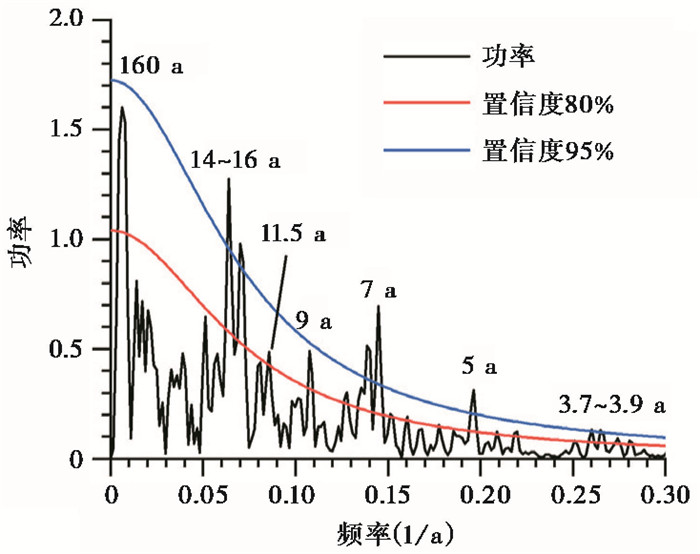
|
图 5 D41石笋δ18O序列REDFIT频谱分析结果 黑色线表示D41石笋δ18O序列谱分析功率曲线,蓝线和红线分别表示95 %和80 %置信度,数字表示序列的周期(单位为年) Fig. 5 Spectral analysis of the D41δ18O time series.The black, red and blue curves represent power, confidences of 80 % and 95 %, respectively. Numbers above curve show the periods(years) |
利用D41石笋δ18O序列重建小冰期阶段董哥洞上游水汽传输路径空间集成降雨量变化记录(图 6),如果如上所述,D41石笋δ18O偏正(负)反映了董哥洞及其上游水汽传输路径上的空间集成降雨量减少(增加),LIA期间空间集成降雨量则存在明显的次级波动,包括多年代际-百年尺度上存在明显的减少(1400~1450A.D.)、增加(1450~1555A.D.)、减少(1555~1630A.D.)到再增加(1630~1780A.D.)的变化趋势和年际-年代际尺度的高频振荡。D41石笋δ18O序列记录主要处于明清两朝期间,嘉靖(1522~1566A.D.)中后期石笋δ18O达到极小值(-8.19 ‰),集成降雨量最大,而后δ18O震荡偏正并在明末维持在较高水平(略高于系列平均值-7.52 ‰),反映集成降雨量波动减少并且在明末维持在一个较低水平,对应了历史上明朝末年干旱频发、社会动乱的情况[11];清朝(1644~1910A.D.)前期至乾隆(1736~1795A.D.)末年,集成降雨量存在缓慢增大的趋势,并伴随明显的年代际波动,可能反映了历史上的一些气候事件[4]。氧同位素偏正最为明显的是1800A.D.附近,在短时间内从-8.1 ‰迅速偏重为-6.7 ‰,变化近1.5 ‰,之后又迅速偏轻至-8 ‰,达到与1790A.D.相近水平,这一事件在印度石笋[70]、阿曼石笋[71]、达索普冰芯[12]、越南北部湖泊[25]、亚洲树轮[31]记录中均有体现,可能对应了1790~1796A.D.的东印度大旱事件(East India Drought)[18, 22, 31]。
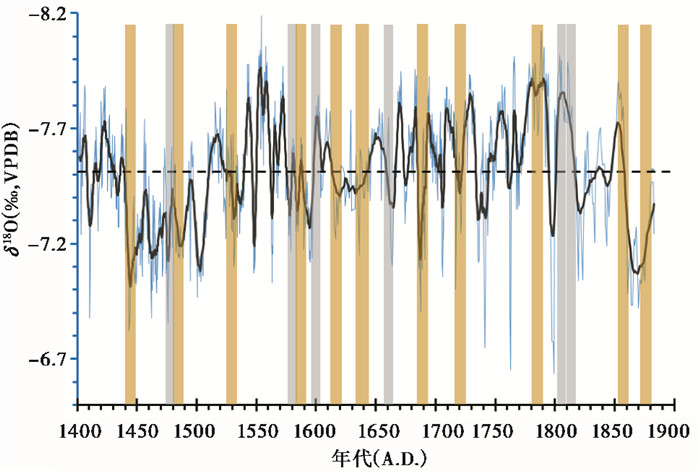
|
图 6 董哥洞D41石笋δ18O记录与极端天气/气候事件对比 蓝色曲线表示D41氧同位素重建的水汽上游传输路径集成降雨量变化序列,黑色曲线为其10点平滑曲线,黑色虚线为δ18O序列平均值;黄色色柱标示文献记录的重大干旱事件时间[10],灰色色柱标示规模大于5级的6次火山活动(数据来自http://volcano.si.edu/ search_eruption.cfm),考虑到年代误差将时间范围扩大 Fig. 6 Comparison of extreme weather/climate events with the D41δ18O record.Blue curve is the D41δ18O record presumably indicating spatially integrated rainfall between moisture source and cave site. The black curve is the 10-point running average of the D41 record. The black dashed line marks the average D41δ18O value. Yellow and gray bars show the major drought events based on the historical documents[10] and 6 volcanic eruptions with Ive>5(http://volcano.si.edu/search_eruption.cfm), respectively. The widths of the vertical bars incorporate the approximate age uncertainties and time ranges of the events |
利用高分辨率石笋记录可以讨论年际、年代际极端天气/气候事件[23]。D41石笋记录与历史文献中记载的干旱事件存在对应关系,根据Zhang等[10]对中国历史文献的整理得出1400~1900A.D.存在11次覆盖范围超过3个省、时间超过2年的干旱事件:1440~1442A.D.、1483~1485A.D.、1527~1529A.D.、1585~1590A.D.、1616~1618A.D.、1638~1643A.D.、1689~1692A.D.、1721~1723A.D.、1784~1786A.D.、1856~1858A.D.和1876~1878A.D.(图 6黄色色柱),在年代误差范围内,11次干旱事件中有9次对应石笋D41的δ18O偏重,但是程度有所不同,表明D41石笋δ18O在记录水汽传输上游集成降雨量的同时也可以反映一定程度的大区域信号(如亚洲夏季风强度或者降雨量等)。此外,D41石笋记录与规模较大的火山爆发活动也存在一定的响应关系,与D41记录同时段世界范围内共有6次级别大于5级的火山活动,其时间分别为1477A.D.、1580A.D.、1600A.D.、1660A.D.、1808A.D.和1815A.D.(图 6灰色色柱,数据来自http://volcano.si.edu/search_eruption.cfm)。在这6次火山喷发活动后,石笋D41的δ18O均显示一定程度的偏重趋势,指示上游集成降雨量减少,这可能与火山活动使大气中气溶胶增加从而导致极地环流减弱,间接抑制降雨有关[18, 72]。
3.4 “崇祯大旱”的不同石笋记录对比明清小冰期期间灾害频发,其中明朝末年的一系列干旱事件强度大、覆盖范围广,被认为对于明清两朝的更替起到了重要作用[9, 73]。文献记录表明明末崇祯年间发生了长达十几年的严重干旱(1628~1643A.D.),即崇祯大旱:早期干旱中心主要是在甘肃、宁夏、陕西、山西、河北境内,后来逐渐扩展到河南、山东、湖北、安徽,最终波及长江中下游的湖南、江西、浙江等地,造成全国大范围的严重干旱[9]。
中国不同地区洞穴石笋δ18O记录在明末崇祯大旱期间显示出了明显的差异(图 7):相对靠北的山东开元洞[74]、甘肃万象洞[4]、湖南莲花洞[17]石笋δ18O均偏重,在年代误差范围内开元洞和万象洞石笋δ18O较整条记录处于明显偏重阶段,莲花洞也显示偏重趋势;而相对靠南的3个洞穴石笋δ18O与之不同:四川神奇洞[37]的δ18O在均值上下波动,且与整条记录相比波动幅度较小,表明没有明显的气候异常;福建玉华洞[24]在该时段表现为两谷一峰,与整个记录相比略显偏负但偏差不大;董哥洞D41石笋的δ18O在该时段略高于序列平均值,气候无显著异常变化。
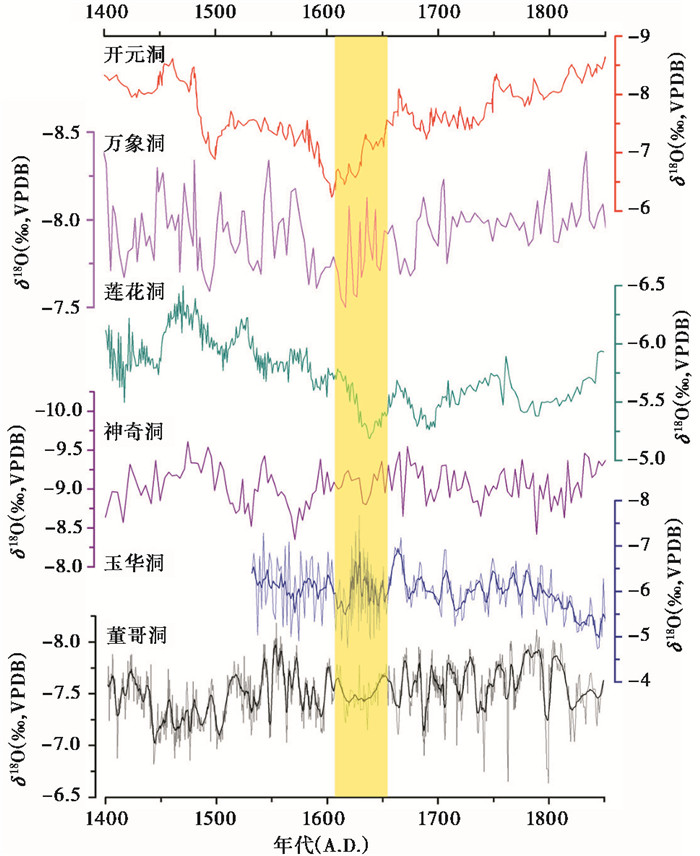
|
图 7 崇祯大旱期间不同地区石笋记录对比 自上而下分别是山东开元洞[74]、甘肃万象洞[4]、湖南莲花洞[17]、四川神奇洞[37]、福建玉华洞[24](深色为5点平滑曲线)以及董哥洞D41石笋(深色为10点平滑曲线);图中黄色色柱标示明末崇祯大旱的时间(1628~1643A.D.),考虑到年代误差将范围扩大 Fig. 7 Comparison of Chinese stalagmiteδ18O records across the Chongzhen Drought.From top to bottom:Stalagmiteδ18O records from Kaiyuan Cave in Shandong[74], Wanxiang Cave in Gansu[4], Lianhua Cave in Hunan[17], Shenqi Cave in Sichuan[37], Yuhua Cave in Fujian[24](darker curve is the 5-point running average), and Dongge Cave in Guizhou(darker curve is the 5-point running average). Yellow bar marks the Chongzhen Drought(1628~1643A.D.), and its time range incorporates the potential age uncertainty and time range of the event |
石笋氧同位素偏重的3个相对靠北的洞穴处于文献记载的崇祯大旱范围内,而石笋氧同位素无显著变化所在的区域均位于史料记载的崇祯大旱范围之外。基于这一发现,本文认为南北洞穴间水汽路径上瑞利分馏的减弱造成了崇祯大旱期间南北不同洞穴石笋记录氧同位素差异:相对偏南的董哥洞、神奇洞和玉华洞记录在事件期间没有表现出明显的偏轻或者偏重现象,表明到达这几个洞穴的大气降水氧同位素组成没有明显变化,但是在水汽继续向北运移的过程中,由于降水减少使得水汽传输路径上的分馏减弱,从而导致其下游的洞穴接收到的降水氧同位素较正常时期明显偏正,进而造成偏北的开元洞、万象洞和莲花洞石笋δ18O明显偏重。
4 结论本文基于董哥洞D41样品U-Th定年及高分辨率稳定同位素数据重建了小冰期期间(1400~1880A.D.)平均分辨率高于0.5年的洞穴上游水汽传输路径上空间集成降雨量变化记录。在重建记录的基础上分析了小冰期内部气候变化的精细特征并与历史文献记载的干旱事件以及世界范围内重大火山活动的时间进行了比较,利用频谱分析研究气候变化的周期特征,并以明末崇祯大旱(1628~1643A.D.)为例对比多个洞穴石笋记录,结合历史文献对于干旱的记载分析短尺度气候变化的区域差异性,并尝试解释不同石笋δ18O差异的原因。主要得到结论如下:
(1) 重建记录显示小冰期内部董哥洞上游空间集成降雨量有着多年代际-百年尺度的变化趋势(1450~1555A.D.和1630~1780A.D.增加,1400~1450A.D.和1555~1630A.D.减少),期间存在年到十年际的高频波动,波动与干旱事件和火山活动可能存在一定的响应关系,表明石笋δ18O能够在一定程度上反映大尺度气候信号。
(2) δ18O序列的功率谱分析结果显示出超过80 %置信度的9年、11.5年、160年周期和超过95 %置信度的4~7年、14~16年周期,可能与太阳活动和ENSO等地球气候系统内部相互作用有关,置信度差异可能反映了LIA期间气候系统内部变率的调节强于太阳活动强迫。
(3) 历史文献记录表明明末崇祯年间发生了一系列干旱事件,干旱区域的南界在四川、重庆、湖南、福建一带。偏北的开元洞、万象洞以及莲花洞石笋氧同位素记录在“崇祯大旱”期间明显偏重,偏南的董哥洞、神奇洞、玉华洞则变化不大,反映了短尺度气候事件的区域差异性;偏北石笋记录位于历史文献记载的干旱区域,而偏南石笋记录在历史文献记录的干旱范围之外。本文认为不同洞穴石笋δ18O差异可以用洞穴上游水汽传输途径上的空间集成降雨量解释:在大旱期间偏南方几个洞穴δ18O没有突出变化的情况下,降水减少可能造成水汽传输路径上的分馏程度降低,使得到达偏北洞穴的大气降水相对偏重,进而导致其洞穴石笋δ18O偏重。
另外,不同洞穴石笋δ18O的明显差异对应了年际-年代际尺度上季风降水在空间上的差异分布,结合季风强度的定义,将个别石笋记录用作季风强度指标可能会产生一定的误解,因此在短时间尺度上将单个石笋氧同位素记录用作亚洲季风强度指标时需要谨慎。
致谢: 非常感谢匿名审稿专家提出的建议和宝贵修改意见;感谢西安交通大学全球环境变化研究院沙丽娟等在绘图中提供的帮助。
| [1] |
Matthes F E. Report of the committee on glaciers, April 1939[J]. Transactions American Geophysical Union, 1939, 20(4): 518-523. DOI:10.1029/TR020i004p00518 |
| [2] |
Matthews J A, Briffa K R. The 'Little Ice Age':Re-valuation of an evolving concept[J]. Geografiska Annaler Series A, Physical Geography, 2005, 87(1): 17-36. DOI:10.1111/j.0435-3676.2005.00242.x |
| [3] |
Cui A N, Ma C M, Zhao L, et al. Pollen records of the Little Ice Age humidity flip in the middle Yangtze River catchment[J]. Quaternary Science Reviews, 2018, 193: 43-53. DOI:10.1016/j.quascirev.2018.06.015 |
| [4] |
Zhang P Z, Cheng H, Edwards R L, et al. A test of climate, sun, and culture relationships from an 1810-year Chinese cave record[J]. Science, 2008, 322(5903): 940-942. DOI:10.1126/science.1163965 |
| [5] |
Ahmed M, Anchukaitis K J, Asrat A, et al. Continental-scale temperature variability during the past two millennia[J]. Nature Geoscience, 2013, 6(5): 339-346. DOI:10.1038/ngeo1797 |
| [6] |
Weiss H, Bradley R S. What drives societal collapse?[J]. Science, 2001, 291(5504): 609-610. DOI:10.1126/science.1058775 |
| [7] |
Gebbie G, Huybers P. The Little Ice Age and 20th-century deep Pacific cooling[J]. Science, 2019, 363(6422): 70-74. DOI:10.1126/science.aar8413 |
| [8] |
赵侃.贵州董哥洞近1000年石笋纹层年代学与同位素气候重建[D].南京: 南京师范大学博士论文, 2011: 13-68. Zhao Kan. Annually-counting Chronology and the Isotopic Climate Reconstruction over the Past Millennia from Stalagmites in Dongge Cave[D]. Nanjing: The Doctoral's Dissertation of Nanjing Normal University, 2011: 13-68. http://cdmd.cnki.com.cn/Article/CDMD-10319-1011187575.htm |
| [9] |
Zheng J Y, Xiao L B, Fang X Q, et al. How climate change impacted the collapse of the Ming Dynasty[J]. Climatic Change, 2014, 127(2): 169-182. DOI:10.1007/s10584-014-1244-7 |
| [10] |
Zhang D E. Severe drought events as revealed in the climate records of China and their temperature situations over the last 1000 years[J]. Acta Meteorologica Sinica, 2005, 19(4): 485-491. |
| [11] |
Ge Q S, Zheng J Y, Hao Z X, et al. General characteristics of climate changes during the past 2000 years in China[J]. Science China:Earth Sciences, 2013, 56(2): 321-329. DOI:10.1007/s11430-012-4370-y |
| [12] |
Thompson L G, Yao T D, Mosley-Thompson E, et al. A high-resolution millennial record of the South Asian Monsoon from Himalayan ice cores[J]. Science, 2000, 289(5486): 1916-1919. DOI:10.1126/science.289.5486.1916 |
| [13] |
Li D L, Li T G, Jiang H, et al. East Asian Winter Monsoon variations and their links to Arctic Sea Ice during the last millennium, inferred from sea surface temperatures in the Okinawa Trough[J]. Paleoceanography and Paleoclimatology, 2018, 33(1): 61-75. DOI:10.1002/palo.v33.1 |
| [14] |
张美良, 朱晓燕, 吴夏, 等. 岩溶洞穴环境及石笋古气候记录[M]. 北京: 地质出版社, 2017: 57-61. Zhang Meiliang, Zhu Xiaoyan, Wu Xia, et al. Karst Cave Environment and Ancient Climate Record of Stalagmites[M]. Beijing: Geological Publishing House, 2017: 57-61. |
| [15] |
Hu C Y, Henderson G M, Huang J H, et al. Quantification of Holocene Asian monsoon rainfall from spatially separated cave records[J]. Earth and Planetary Science Letters, 2008, 266(3): 221-232. |
| [16] |
Tan L C, Cai Y J, An Z S, et al. Centennial to decadal-scale monsoon precipitation variability in the semi-humid region, Northern China during the last 1860 years:Records from stalagmites in Huangye Cave[J]. The Holocene, 2011, 21(2): 287-296. DOI:10.1177/0959683610378880 |
| [17] |
Yin J J, Yuan D X, Li H C, et al. Variation in the Asian monsoon intensity and dry-wet condition since the Little Ice Age in Central China revealed by an aragonite stalagmite[J]. Climate of the Past, 2014, 10(5): 1803-1816. DOI:10.5194/cp-10-1803-2014 |
| [18] |
蒋文静, 赵侃, 陈仕涛, 等. 小冰期十年际尺度亚洲季风变化的四川黑竹沟洞石笋记录[J]. 第四纪研究, 2017, 37(1): 118-129. Jiang Wenjing, Zhao Kan, Chen Shitao, et al. Decadal climate oscillations during the Little Ice Age of stalagmite record from Heizhugou Cave, Sichuan[J]. Quaternary Sciences, 2017, 37(1): 118-129. |
| [19] |
杨勋林, 陈发虎, 袁道先, 等. 高分辨率石笋记录的三峡库区小冰期气候变化[J]. 地理科学, 2013, 33(5): 629-634. Yang Xunlin, Chen Fahu, Yuan Daoxian, et al. Climate change during Little Ice Age with high resolution stalagmite record in the Three-Gorges Reservoir area[J]. Scientia Geographica Sinica, 2013, 33(5): 629-634. |
| [20] |
何尧启, 汪永进, 孔兴功, 等. 贵州董哥洞近1000 a来高分辨率洞穴石笋δ18O记录[J]. 科学通报, 2005, 50(11): 1114-1118. He Yaoqi, Wang Yongjin, Kong Xinggong, et al. High resolution stalagmite δ18O records over the past 1000 years from Dongge Cave in Guizhou[J]. Chinese Science Bulletin, 2005, 50(10): 1003-1008. |
| [21] |
Duan F C, Wang Y J, Shen C C, et al. Evidence for solar cycles in a Late Holocene speleothem record from Dongge Cave, China[J]. Scientific Reports, 2014, 4(7503): 5159. DOI:10.1038/srep05159 |
| [22] |
Zhao K, Wang Y J, Edwards R L, et al. A high-resolved record of the Asian summer monsoon from Dongge Cave, China for the past 1200 years[J]. Quaternary Science Reviews, 2015, 122: 250-257. DOI:10.1016/j.quascirev.2015.05.030 |
| [23] |
Tan L C, Cai Y J, Cheng H, et al. Summer monsoon precipitation variations in Central China over the past 750 years derived from a high-resolution absolute-dated stalagmite[J]. Palaeogeography, Palaeoclimatology, Palaeoecology, 2009, 280(3): 432-439. |
| [24] |
姜修洋, 李志忠, 李金全, 等. 最近500年来福建玉华洞石笋氧同位素记录及气候意义[J]. 地理科学, 2012, 32(2): 207-212. Jiang Xiuyang, Li Zhizhong, Li Jinquan, et al. Stalagmite δ18O record from Yuhua Cave over the past 500 years and its regional climate significance[J]. Scientia Geographica Sinica, 2012, 32(2): 207-212. |
| [25] |
Stevens L R, Buckley B M, Kim S, et al. Increased effective moisture in northern Vietnam during the Little Ice Age[J]. Palaeogeography, Palaeoclimatology, Palaeoecology, 2018, 511: 449-461. DOI:10.1016/j.palaeo.2018.09.011 |
| [26] |
郭超, 马玉贞, 刘杰瑞, 等. 过去2000年来西藏羊卓雍错沉积物粒度记录的气候变化[J]. 第四纪研究, 2016, 36(2): 405-419. Guo Chao, Ma Yuzhen, Liu Jierui, et al. Climatic change recorded by grain-size in the past about 2000 years from Yamzhog Yumco Lake, Tibet[J]. Quaternary Sciences, 2016, 36(2): 405-419. |
| [27] |
Yan H, Sun L G, Oppo D W, et al. South China Sea hydrological changes and Pacific Walker Circulation variations over the last millennium[J]. Nature Communications, 2011, 2(1): 293. DOI:10.1038/ncomms1297 |
| [28] |
李亮, 马春梅, 鹿化煜, 等. 江西中部玉华山沼泽泥炭记录的过去两千年气候变化初步研究[J]. 第四纪研究, 2017, 37(3): 548-559. Li Liang, Ma Chunmei, Lu Huayu, et al. A preliminary study of the climate change since 2 ka archived by a peat core from Yuhua Mountain in the middle Jiangxi Province[J]. Quaternary Sciences, 2017, 37(3): 548-559. |
| [29] |
阳小兰, 张茹春, 张振, 等. 安固里淖湖近5000年来环境变化的孢粉及地球化学沉积记录[J]. 第四纪研究, 2017, 37(1): 130-142. Yang Xiaolan, Zhang Ruchun, Zhang Zhen, et al. Environmental change since 5000 cal.a B. P. in the Anguli-Nuur Lake area based on palynological and geochemical records[J]. Quaternary Sciences, 2017, 37(1): 130-142. |
| [30] |
覃军干, 张新荣, 张强, 等. 近1000年以来气候波动在广西桂北地区沉积物中的记录[J]. 第四纪研究, 2016, 36(2): 268-277. Qin Jungan, Zhang Xinrong, Zhang Qiang, et al. Climate oscillations recorded in the sediment from north Guilin, Guangxi during the past 1000 years[J]. Quaternary Sciences, 2016, 36(2): 268-277. |
| [31] |
Cook E R, Anchukaitis K J, Buckley B M, et al. Asian Monsoon failure and megadrought during the last millennium[J]. Science, 2010, 328(5977): 486-489. DOI:10.1126/science.1185188 |
| [32] |
Liu Y, Cobb K M, Song H, et al. Recent enhancement of central Pacific El Niño variability relative to last eight centuries[J]. Nature Communications, 2017, 8: 15386. DOI:10.1038/ncomms15386 |
| [33] |
Peng Y B, Cheng H, Shen C M, et al. Past millennium contrasting hydroclimate patterns between monsoonal Northern China and Arid Central Asia:A modeling study[J]. Asia-Pacific Journal of Atmospheric Sciences, 2018, 54(3): 445-455. DOI:10.1007/s13143-018-0010-6 |
| [34] |
周秀骥, 赵平, 刘舸, 等. 中世纪暖期、小冰期与现代东亚夏季风环流和降水年代-百年尺度变化特征分析[J]. 科学通报, 2011, 56(25): 2060-2067. Zhou Xiuji, Zhao Ping, Liu Ge, et al. Characteristics of decadal-centennial-scale changes in East Asian summer monsoon circulation and precipitation during the Medieval Warm Period and Little Ice Age and in the present day[J]. Chinese Science Bulletin, 2011, 56(28-29): 3003-3011. |
| [35] |
Chen J H, Chen F H, Feng S, et al. Hydroclimatic changes in China and surroundings during the Medieval Climate Anomaly and Little Ice Age:Spatial patterns and possible mechanisms[J]. Quaternary Science Reviews, 2015, 107: 98-111. DOI:10.1016/j.quascirev.2014.10.012 |
| [36] |
张娴, 邵晓华, 王涛. 中国小冰期气候研究综述[J]. 南京信息工程大学学报(自然科学版), 2013, 5(4): 317-325. Zhang Xian, Shao Xiaohua, Wang Tao. Regional climate characteristics in China during the Little Ice Age[J]. Journal of Nanjing University of Information Science and Technology(Natural Science Edition), 2013, 5(4): 317-325. |
| [37] |
Tan L C, Cai Y J, Cheng H, et al. High resolution monsoon precipitation changes on southeastern Tibetan Plateau over the past 2300 years[J]. Quaternary Science Reviews, 2018, 195: 122-132. DOI:10.1016/j.quascirev.2018.07.021 |
| [38] |
王绍武. 中世纪暖期与小冰期[J]. 气候变化研究进展, 2010, 6(5): 388-390. Wang Shaowu. Medieval Warm Period and Little Ice Age[J]. Advances in Climate Change Research, 2010, 6(5): 388-390. DOI:10.3969/j.issn.1673-1719.2010.05.015 |
| [39] |
王绍武, 闻新宇, 罗勇, 等. 近千年中国温度序列的建立[J]. 科学通报, 2007, 52(8): 958-964. Wang Shaowu, Wen Xinyu, Luo Yong, et al. Reconstruction of temperature series of China for the last 1000 years[J]. Chinese Science Bulletin, 2007, 52(23): 3272-3280. |
| [40] |
Wang Y J, Cheng H, Edwards R L, et al. The Holocene Asian monsoon:Links to solar changes and North Atlantic climate[J]. Science, 2005, 308(5723): 854-857. DOI:10.1126/science.1106296 |
| [41] |
Yuan D X, Cheng H, Edwards R L, et al. Timing, duration, and transitions of the last interglacial Asian monsoon[J]. Science, 2004, 304(5670): 575-578. DOI:10.1126/science.1091220 |
| [42] |
Dykoski C A, Edwards R L, Hai C, et al. A high-resolution, absolute-dated Holocene and deglacial Asian monsoon record from Dongge Cave, China[J]. Earth and Planetary Science Letters, 2005, 233(1): 71-86. |
| [43] |
Kelly M J, Edwards R L, Cheng H, et al. High resolution characterization of the Asian monsoon between 146, 000 and 99, 000 years BP from Dongge Cave, China and global correlation of events surrounding Termination Ⅱ[J]. Palaeogeography, Palaeoclimatology, Palaeoecology, 2011, 236(1): 20-38. |
| [44] |
张美良, 程海, 林玉石, 等. 贵州荔波1.5万年以来石笋高分辨率古气候环境记录[J]. 地球化学, 2004, 33(1): 65-74. Zhang Meiliang, Cheng Hai, Lin Yushi, et al. High resolution paleoclimatic environment records from a stalagmite of Dongge Cave since 15000 a in Libo, Guizhou Province, China[J]. Geochimica, 2004, 33(1): 65-74. DOI:10.3321/j.issn:0379-1726.2004.01.009 |
| [45] |
Li X L, Cheng H, Tan L C, et al. The East Asian summer monsoon variability over the last 145 years inferred from the Shihua Cave record, North China[J]. Scientific Reports, 2017, 7(1): 7078. DOI:10.1038/s41598-017-07251-3 |
| [46] |
Edwards R L, Chen J H, Wasserburg G J. 238U-234U-230Th-232Th systematics and the precise measurement of time over the past 500, 000 years[J]. Earth and Planetary Science Letters, 1987, 81(2-3): 175-192. DOI:10.1016/0012-821X(87)90154-3 |
| [47] |
Cheng H, Edwards R L, Shen C C, et al. Improvements in 230Th dating, 230Th and234 U half-life values, and U-Th isotopic measurements by multi-collector inductively coupled plasma mass spectrometry[J]. Earth and Planetary Science Letters, 2013, 371-372: 82-91. DOI:10.1016/j.epsl.2013.04.006 |
| [48] |
Hercman H, Pawlak J. MOD-AGE:An age-depth model construction algorithm[J]. Quaternary Geochronology, 2012, 12(12): 1-10. |
| [49] |
程海, 艾思本, 王先锋, 等. 中国南方石笋氧同位素记录的重要意义[J]. 第四纪研究, 2005, 25(2): 157-163. Cheng Hai, Edwards R L, Wang Xianfeng, et al. Oxygen isotope records of stalagmites from Southern China[J]. Quaternary Sciences, 2005, 25(2): 157-163. DOI:10.3321/j.issn:1001-7410.2005.02.004 |
| [50] |
Dorale J A, Liu Z. Limitations of Hendy Test criteria in judging the paleoclimatic suitability of speleothems and the need for replication[J]. Journal of Cave and Karst Studies, 2009, 71(1): 73-80. |
| [51] |
赵景耀, 杨琰, 彭涛, 等. 河南鸡冠洞降水、滴水和现生碳酸钙的δ18O变化特征及其环流意义[J]. 第四纪研究, 2014, 34(5): 1106-1116. Zhao Jingyao, Yang Yan, Peng Tao, et al. Variation of δ18O values in the precipitation, cave water and modern calcite deposition in Jiguan Cave, Henan Province and its atmospheric circulation effect[J]. Quaternary Sciences, 2014, 34(5): 1106-1116. |
| [52] |
Lachniet M S. Climatic and environmental controls on speleothem oxygen-isotope values[J]. Quaternary Science Reviews, 2009, 28(5): 412-432. |
| [53] |
Wang Y J, Cheng H, Edwards R L, et al. A high-resolution absolute-dated Late Pleistocene monsoon record from Hulu Cave, China[J]. Science, 2001, 294(5550): 2345-2348. DOI:10.1126/science.1064618 |
| [54] |
Cheng H, Edwards R L, Broecker W S, et al. Ice age terminations[J]. Science, 2009, 326(5950): 248-252. DOI:10.1126/science.1177840 |
| [55] |
谭明. 环流效应:中国季风区石笋氧同位素短尺度变化的气候意义——古气候记录与现代气候研究的一次对话[J]. 第四纪研究, 2009, 29(5): 851-862. Tan Ming. Circulation effect:Climatic significance of the short term variability of the oxygen isotopes from monsoon China-Dialogue between paleoclimate records and modern climate research[J]. Quaternary Sciences, 2009, 29(5): 851-862. DOI:10.3969/j.issn.1001-7410.2009.05.01 |
| [56] |
谭明, 南素兰. 中国季风区降水氧同位素年际变化的"环流效应"初探[J]. 第四纪研究, 2010, 30(3): 620-622. Tan Ming, Nan Sulan. Primary investigation on interannual changes in the circulation effect of precipitation oxygen isotopes in monsoon China[J]. Quaternary Sciences, 2010, 30(3): 620-622. DOI:10.3969/j.issn.1001-7410.2010.03.21 |
| [57] |
Tan M. Circulation effect:Response of precipitation δ18O to the ENSO cycle in monsoon regions of China[J]. Climate Dynamics, 2014, 42(3-4): 1067-1077. DOI:10.1007/s00382-013-1732-x |
| [58] |
谭明. 近千年气候格局的环流背景:ENSO态的不确定性分析与再重建[J]. 中国科学:地球科学, 2016, 59(5): 657-673. Tan Ming. Circulation background of climate patterns in the past millennium:Uncertainty analysis and re-reconstruction of ENSO-like state[J]. Science China:Earth Sciences, 2016, 59(6): 1225-1241. |
| [59] |
张键, 李廷勇. "雨量效应"与"环流效应":近1 ka亚澳季风区石笋和大气降水δ18O的气候意义[J]. 第四纪研究, 2018, 38(6): 1532-1544. Zhang Jian, Li Tingyong. "Amount effect" vs."Circulation effect":The climate significance of precipitation and stalagmite δ18O in the Asian-Australian monsoon region over the past 1 ka[J]. Quaternary Sciences, 2018, 38(6): 1532-1544. |
| [60] |
谭明, 南素兰, 段武辉. 中国季风区大气降水同位素的季节尺度环流效应[J]. 第四纪研究, 2016, 36(3): 575-580. Tan Ming, Nan Sulan, Duan Wuhui. Seasonal scale circulation effect of stable isotope in atmospheric precipitation in the monsoon regions of China[J]. Quaternary Sciences, 2016, 36(3): 575-580. |
| [61] |
何璐瑶, 胡超涌, 黄俊华, 等. 石笋氧同位素指示东亚季风大尺度环流特征[J]. 第四纪研究, 2009, 29(5): 950-956. He Luyao, Hu Chaoyong, Huang Junhua, et al. Characteristics of largescale circulation of East Asian monsoon indicated by oxygen isotope of stalagmite[J]. Quaternary Sciences, 2009, 29(5): 950-956. DOI:10.3969/j.issn.1001-7410.2009.05.12 |
| [62] |
Maher B A. Holocene variability of the East Asian summer monsoon from Chinese cave records:A re-assessment[J]. The Holocene, 2008, 18(6): 861-866. DOI:10.1177/0959683608095569 |
| [63] |
Cheng H, Edwards R L, Sinha A, et al. The Asian monsoon over the past 640, 000 years and ice age terminations[J]. Nature, 2016, 534(7609): 640-646. DOI:10.1038/nature18591 |
| [64] |
孙喜利, 杨勋林, 史志超, 等. 石笋记录的西南地区MIS 4阶段夏季风的演化[J]. 第四纪研究, 2017, 37(6): 1370-1380. Sun Xili, Yang Xunlin, Shi Zhichao, et al. The evolution of summer monsoon in Southwest China during MIS 4 as revealed by stalagmite δ18O record[J]. Quaternary Sciences, 2017, 37(6): 1370-1380. |
| [65] |
崔梦月, 洪晖, 孙晓双, 等. 福建仙云洞石笋记录的新仙女木突变事件结束时的缓变特征[J]. 第四纪研究, 2018, 38(3): 711-719. Cui Mengyue, Hong Hui, Sun Xiaoshuang, et al. The gradual change characteristics at the end of the Younger Dryas event inferred from a speleothem record from Xianyun Cave, Fujian Province[J]. Quaternary Sciences, 2018, 38(3): 711-719. |
| [66] |
杨琰, 袁道先, 程海, 等. 末次冰消期亚洲季风突变事件的精确定年:以贵州衙门洞石笋为例[J]. 中国科学:地球科学, 2010, 53(2): 199-210. Yang Yan, Yuan Daoxian, Cheng Hai, et al. Precise dating of abrupt shifts in the Asian Monsoon during the last deglaciation based on stalagmite data from Yamen Cave, Guizhou Province, China[J]. Science China:Earth Sciences, 2010, 53(5): 633-641. |
| [67] |
Berger W H, Rad U. Decadal to millennial cyclicity in varves and turbidites from the Arabian Sea:Hypothesis of tidal origin[J]. Global and Planetary Change, 2002, 34(3): 313-325. |
| [68] |
刘秦玉, 李春, 胡瑞金. 北太平洋的年代际振荡与全球变暖[J]. 气候与环境研究, 2010, 15(2): 217-224. Liu Qinyu, Li Chun, Hu Ruijin. Interdecadal oscillations in the North Pacific and the global warming[J]. Climatic and Environmental Research, 2010, 15(2): 217-224. DOI:10.3878/j.issn.1006-9585.2010.02.12 |
| [69] |
杨秋明, 钱玮, 李熠, 等. 登陆中国热带风暴年际和年代际变化及其与全球大尺度环流的相关[J]. 气候变化研究进展, 2011, 7(4): 243-247. Yang Qiuming, Qian Wei, Li Yi, et al. Principal time modes of the interannual and decadal variations of landfall tropical storm number in China and their relationships to the global large scale circulation[J]. Advances in Climate Change Research, 2011, 7(4): 243-247. DOI:10.3969/j.issn.1673-1719.2011.04.002 |
| [70] |
Sinha A, Berkelhammer M, Stott L, et al. The leading mode of Indian summer monsoon precipitation variability during the last millennium[J]. Geophysical Research Letters, 2011, 38(15): 532-560. |
| [71] |
Fleitmann D, Burns S J, Neff U, et al. Palaeoclimatic interpretation of high-resolution oxygen isotope profiles derived from annually laminated speleothems from Southern Oman[J]. Quaternary Science Reviews, 2004, 23(7): 935-945. |
| [72] |
Rubino M, Etheridge D M, Trudinger C M, et al. Low atmospheric CO2 levels during the Little Ice Age due to cooling-induced terrestrial uptake[J]. Nature Geoscience, 2016, 9(9): 691-694. DOI:10.1038/ngeo2769 |
| [73] |
Cheng H, Edwards R L, Haug G H. Comment on "On linking climate to Chinese dynastic change:Spatial and temporal variations of monsoonal rain"[J]. Chinese Science Bulletin, 2010, 55(32): 3734-3737. DOI:10.1007/s11434-010-4122-3 |
| [74] |
王庆, 周厚云, 迟宏, 等. 最近千年来山东半岛西部气候环境变化的石笋δ18O、δ 13C记录(Ⅰ)[J]. 海洋地质与第四纪地质, 2015, 35(5): 135-142. Wang Qing, Zhou Houyun, Chi Hong, et al. The stalagmite records of climate and environment change on the western Shandong Peninsula during the past 1000 years:δ18O and δ13C values(Ⅰ)[J]. Marine Geology & Quaternary Geology, 2015, 35(5): 135-142. |
2 Institute of Karst Geology, China Institute of Geological Sciences/Key Laboratory of Karst Dynamics, MLR & GZAR, Guilin 541004, Guangxi)
Abstract
High-resolution and precisely dated climate records are important to further investigate the climate variability during the Little Ice Age(LIA). On the basis of 24 230Th dates and 1165 oxygen and carbon isotope data obtained from stalagmite D41(sample length for 11.7 mm) from Dongge Cave(25°17'50.5"N, 108°02'67"E), Libo, Guizhou, we present here a high-resolution(average resolution better than 0.5 year) δ18O and δ13C record across a large portion of the LIA(1400~1880 A.D.).The δ18O values in the D41 record vary from -8.19 ‰ to -6.64 ‰ with the average value of -7.52 ‰. There exists a significant positive correlation between the δ18O and δ13C(Pearson linear correlation coefficient r=0.7882, n=1165, p < 0.001). The δ18O record shows low excursions during the periods of 1450~1555 A.D. and 1630~1780 A.D., and high excursions during 1400~1450 A.D. and 1555~1630 A.D., with interannual-decadal fluctuations between throughout the record. Power spectrum analysis of the D41 δ18O revealed periodicities of 160, 11.5 and 9 years similar to solar radiation cycles, as well as periodicity of 4~7 years similar to the ENSO cycle. Additionally, a 14~16-year periodicity appears to be prominent, which may reflect the influence of sea-air circulations and other interaction between different Earth's climate systems.In principle, the lower δ18O in the D41 record may mainly reflect larger spatially integrated rainfall between the cave site and moisture source along water vapor transmission path. The secondary fluctuations of the D41 δ18O variance may response to large-scale volcanic and drought events. A close look at different stalagmite δ18O records during the Chongzhen Drought(1628~1643 A.D.) reveals a drought/wet boundary in line with the historical documents. We suggest that the significant differences of δ18O in stalagmites could be explained by the change of spatial integrated rainfall between the cave site and its upstream rainfall along the moisture transmission path. As such, the high excursions observed in cave δ18O records from northern China, compared with the absence of the equivalent events in cave δ18O records from southern China during the Chongzhen Drought event, suggest that the rainfall reduce during the event occurred mainly between the northern and southern cave sites, broadly consistent with the historical documents. Moreover, observations of the temporal and spatial difference between different stalagmite δ18O records call for a caution to use a single stalagmite δ18O record as an indicator of Asian Monsoon intensity on annual to decadal timescales. 2019, Vol.39
2019, Vol.39

